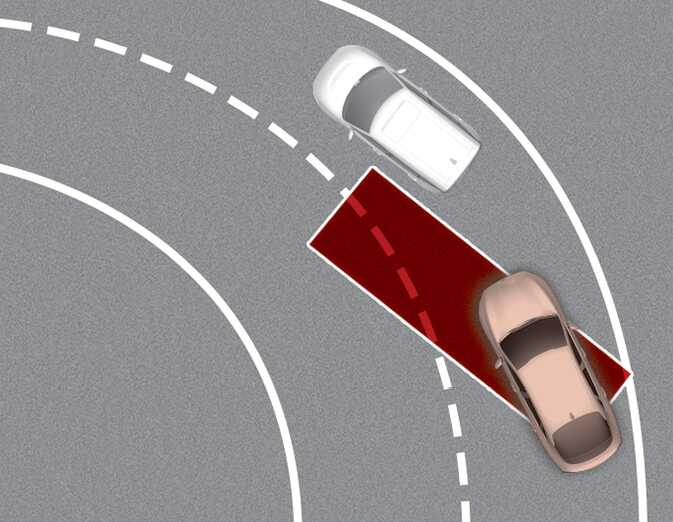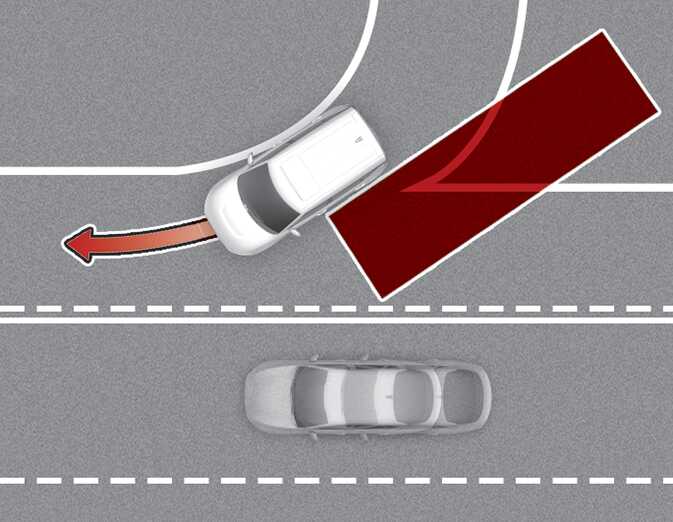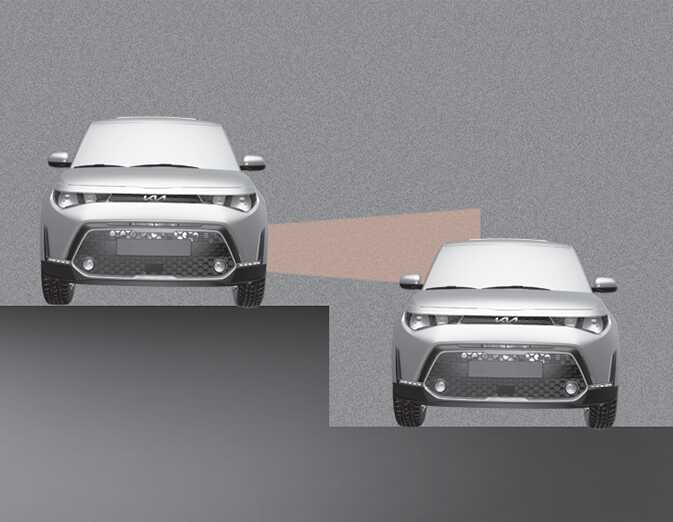Limitations of Blind-Spot Collision-Avoidance Assist
Blind-Spot Collision-Avoidance Assist may not operate properly, or it may operate unexpectedly under the following circumstances:
-
There is inclement weather, such as heavy snow, heavy rain, etc.
-
The detecting sensor is covered with snow, rain, dirt, etc.
-
The temperature around the detecting sensor is high or low due to surrounding environment.
-
The detecting sensor is blocked while driving near a vehicle, pillar, or wall.
-
Driving on a highway (or motorway) ramp or driving through a tollgate.
-
The road pavement (or the peripheral ground) abnormally contains metallic components (for example, possibly due to subway construction).
-
There is a fixed object near the vehicle, such as sound barriers, guardrails, central dividers, entry barriers, street lamps, signs, tunnels, walls, etc. (including double structures)
-
Driving through a narrow road where trees or grass are overgrown
-
Driving in vast areas where there are few vehicles or structures (for example, desert, meadow, suburb, etc.)
-
Driving on a wet road surface, such as a puddle on the road
-
The other vehicle drives very close behind your vehicle, or the other vehicle passes by your vehicle in close proximity
-
The speed of the other vehicle is very fast that it passes by your vehicle in a short time
-
Your vehicle passes by the other vehicle
-
Your vehicle changes lane
-
Your vehicle has started at the same time as the vehicle next to you and has accelerated
-
The vehicle in the next lane moves two lanes away from you, or when the vehicle two lanes away moves to the next lane from you
-
A trailer or carrier is installed around the rear corner radar
-
The bumper around the rear corner radar is covered with objects, such as a bumper sticker, bike rack, etc.
-
The bumper around the rear corner radar is impacted, damaged or the radar is out of position
-
Your vehicle height is low or high due to heavy loads, abnormal tire pressure, etc.
-
When the following objects are detected:
-
A bicycle is detected
-
A vehicle such as a flat trailer is detected
-
A big vehicle such as a bus or truck is detected
-
A moving obstacle such as a pedestrian, animal, shopping cart or a baby stroller is detected
-
A vehicle with low height such as a sports car is detected
-
Braking control may not work, driver's attention is required in the following circumstances:
-
The vehicle severely vibrates while driving over a bumpy road, uneven road or concrete patch
-
Driving on a slippery surface due to snow, water puddle, ice, etc.
-
The tire pressure is low or a tire is damaged
-
The braking system has been modified
-
The vehicle makes abrupt lane changes
-
Driving on a curved road
 OSK3052383L
OSK3052383LBlind-Spot Collision-Avoidance Assist may not operate properly when driving on a curved road. Blind-Spot Collision-Avoidance Assist may not detect the vehicle in the next lane.
Always pay attention to road and driving conditions while driving.
 OSK3052384L
OSK3052384LBlind-Spot Collision-Avoidance Assist may not operate properly when driving on a curved road. Blind-Spot Collision-Avoidance Assist may detect a vehicle in the same lane.
Always pay attention to road and driving conditions while driving.
-
Driving on a sloped road
 OSK3052031L
OSK3052031LBlind-Spot Collision-Avoidance Assist may not operate properly when driving on a slope. The function may not detect the vehicle in the next lane or may incorrectly detect the ground or structure.
Always pay attention to road and driving conditions while driving.
-
Driving where the road is merging/dividing
 OSK3052030L
OSK3052030LBlind-Spot Collision-Avoidance Assist may not operate properly when driving where the road merges or divides. The function may not detect the vehicle in the next lane.
Always pay attention to road and driving conditions while driving.
-
Driving where the heights of the lanes are different
 OSK3052032N
OSK3052032NBlind-Spot Collision-Avoidance Assist may not operate properly when driving where the heights of the lanes are different. The function may not detect the vehicle on a road with different lane heights (underpass joining section, grade separated intersections, etc.).
Always pay attention to road and driving conditions while driving.
-
When you are towing a trailer or another vehicle, make sure that you turn off Blind-Spot Collision-Avoidance Assist. If you tow a European spec trailer, the function may be limited.
-
Blind-Spot Collision-Avoidance Assist may not operate properly if interfered by strong electromagnetic waves.
-
Blind-Spot Collision-Avoidance Assist may not operate for 3 seconds after the vehicle is started, or the front view camera or rear corner radars are initialized.
This device complies with Part 15 of the FCC rules.
Operation is subject to the following two conditions:
-
This device may not cause harmful interference, and
-
This device must accept any interference received, including interference that may cause undesired operation.
